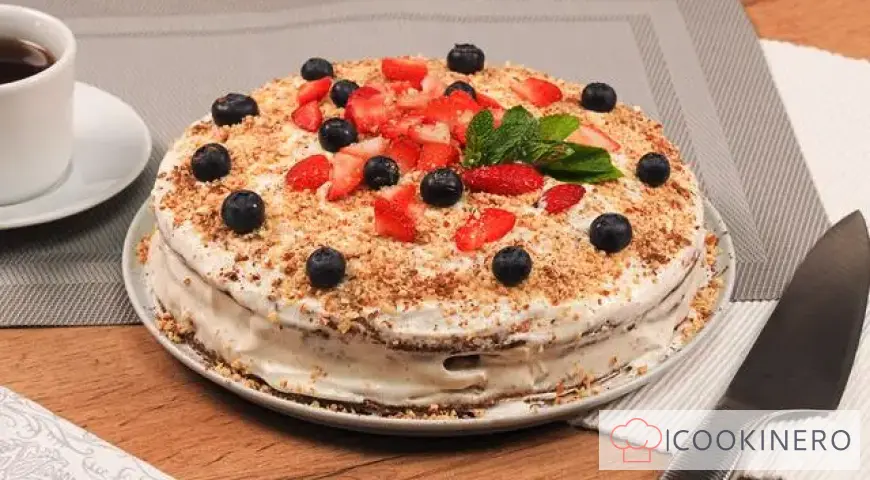Chocolate cake with lemon and candied ginger from Elena Bon

A very soft yeast cake with a chocolate-gingerbread taste and aroma, based on melted milk and dark chocolate, red wine and rum, with the addition of candied lemon and ginger and walnuts, with delicate chocolate icing ... Its original recipe, which was recorded yet in my old cookbook, I was not very satisfied, because, despite all the costs and efforts, according to him, the cake turned out to be more like bread than real holiday pastries. I had to work hard on it and refine it so that now I could offer the final version to you. The method of preparing such a cake is as simple as possible. Its dough can be made both by the “cold proofing” method (like my other “Davydovsky” cake - kulich-davydovskij), and the usual one - in a warm place or at room temperature.
How to cook Chocolate cake with lemon and candied ginger from Elena Bon
Step 1

Remove the butter in advance (2-3 hours before kneading the dough) from the refrigerator so that it becomes very soft, creamy, or soften it in the microwave immediately before cooking. Also, take the eggs out ahead of time. Chocolate, wine and rum should also be at room temperature.
Step 2

In separate containers, measure the required amount of flour (regular and fine grinding) with salt; sugar and spices.
Step 3

Melt the chocolate in a water bath, then remove from it and set aside until use.
Step 4

Measure the amount of milk required according to the recipe and heat in a saucepan or aluminum bowl over low heat until warm (40 ° C). Pour dry or crumble fresh yeast into it and let it get wet for about 5 minutes.
Step 5

Hang and cut walnuts and candied fruits into medium pieces and sprinkle them with 1 tbsp. l. flour from the total amount measured earlier. Mix well.
Step 6

Break the eggs into a large (at least 3.5 l) container for kneading the dough and beat with a mixer with ordinary whisks into a fluffy foam, then add ½ of the granulated sugar measured in step 2 to them, beat and add the rest of the sugar. Again, beat everything until fluffy.
Step 7

Pour milk with yeast over eggs. Mix with mixer on medium speed.
Step 8

In 2-3 doses, enter into the dough ½ of the flour measured in paragraph 2 with salt, as well as all the spices, after sifting everything through a sieve. Mix everything thoroughly to get rid of lumps. The dough will be thick.
Step 9

Add melted and cooled chocolate and softened butter to the dough. Stir the contents of the container until smooth, then add rum, wine and lemon juice with zest in turn, mixing everything thoroughly each time.
Step 10

Change the beaters on the mixer to beaters for yeast dough and in portions (in 2-3 steps) add the rest of the flour to the dough, also sifting and kneading it with a mixer at low speed each time.
Step 11

Add candied fruits and nuts to the dough along with the flour in which you rolled them. After that, remove the remaining unmixed flour from the edges of the bowl and mix everything again, while reaching the bottom of the container with the beaters of the mixer. The dough will be very sticky.
Step 12

Transfer the finished dough (preferably using a special silicone spatula or scraper) into a large saucepan (about 4-5 liters in volume), level its surface, cover with plastic wrap and leave to proof in a warm place for 2-2.5 hours or, if You have chosen the “cold method”, put it in the refrigerator for 8-12 hours (but not more than 12). Note: For the further procedure for the second method, see the recipe "Kulich "Davydovsky". When proofing in the refrigerator, the dough does not increase much in volume.
Step 13
Turn on the oven and heat it to 3-3.5 (about 170-190 ° C), if necessary, first lowering the grate one level from the middle one, since Easter cakes will increase during baking.
Step 14

While the dough is rising, prepare the paper molds. Lower the risen dough (knead it) with a special culinary spatula and arrange it in the existing forms (filling them no more than ⅓-½). Level the surfaces of future Easter cakes as much as possible. I usually divide the dough with a 400 g scale into 4 molds and put the rest (weighing about 450 g) in the remaining last larger pan.
Step 15

Place the molds on one or more baking sheets (if possible so that they do not touch each other). Cover the top of the molds with a regular cloth or paper towel or plastic wrap and let the dough rise in a warm place (no drafts) and rise to ¾ of the height of the molds or a little higher. This may take about 1.5-2 hours.
Step 16

When the dough rises well and its volume increases, put the cakes in the oven. Bake them on the number 3-3.5 (about 170-190 ° C) for 45 minutes or according to the recommendations in the instructions for your oven for baking yeast dough. The readiness of Easter cakes can be determined by piercing them with a wooden stick - if the dough does not stick to it, the Easter cake is ready. Try not to slam the oven door when checking or removing Easter cakes, as this can cause them to settle. Tip: If desired, after 25-30 minutes. after the start of baking, you can grease the top of the Easter cakes with egg yolk, beaten with 1 tsp. milk - for shine.
Step 17

Carefully remove the finished Easter cakes from the oven, cover with paper towels and let them cool completely right on the baking sheet at room temperature, protecting them from drafts.
Step 18

When the Easter cakes stand - 20-24 hours after baking, they can be covered with chocolate icing. Before that, you can remove the paper forms and cut off the burnt places near the cakes or decorate the cakes directly in the forms.
Step 19

For the icing, melt the chocolate in a water bath and immediately spread it over the top of the cakes with a spoon. Cut the candied fruit into small diamonds and arrange randomly on the glaze. Let the glaze dry for at least 3 hours at room temperature, without covering. Be careful - until the glaze has hardened, any touch will leave marks on it.
Step 20

Ready-made Easter cakes can be stored at room temperature, covered with a paper towel, for about 7 days. Over time, their crumb will dry out and become crumbly, but no less tasty than fresh. Easter cakes left in paper forms will retain their soft structure longer. In addition, you can store ready-made Easter cakes in the refrigerator in separate closed plastic bags (paper forms do not need to be removed), and before serving a specific cake, remove the bag and form, cut off the burnt bottom and edges if necessary and let it stand at room temperature 1 -1,5 hour.
Chocolate cake with lemon and candied ginger from Elena Bon - FAQ About Ingredients, Baking Time and Storage
Reviews: 0
0 Overall ratingHave you already prepared this recipe? Tell what you think.
Write a review
Trending

Honey mushroom soup
Frozen honey mushrooms allow you to enjoy the taste and aroma of mushroom soup even in winter. There are many recipes with honey mushrooms and other frozen or dried mushrooms in traditional Russian cuisine. But soup with honey mushrooms, frozen whole

Apple marshmallow
Apple marshmallows can be considered a healthy homemade treat. The low-calorie dessert is made by making marshmallows from applesauce. In order for homemade apple marshmallows to hold their shape well, they need to be made with gelatin. According to

Kharcho with chicken
Usually kharcho is cooked in beef broth. But we decided to break the rules to get a slightly different, but no less tasty dish. Kharcho based on chicken will be more dietary, but in taste it will be the same famous Georgian soup, which you can easily

Salad "Tbilisi"
Tbilisi salad is a popular Georgian salad with beef, red beans, sweet peppers, cilantro and walnuts. It is distinguished by its fresh spicy taste, because chili peppers, garlic and khmeli-suneli spices are added to it. The salad is traditionally dres

Beef knuckle
The special value of the beef knuckle (the lower part of the beef carcass leg) is the marrow bone, rich in nutrients. The recipe recommends using meat from young animals no more than 20 months old. It can be distinguished by the rich red and pink col

Azu in Tatar style
Azu is a Tatar dish that gained popularity in Soviet times. Traditionally, azu is made from lamb or beef, with onions, potatoes and pickles added. Everything is cut into strips and stewed in tomato sauce.








